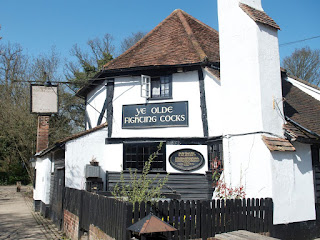Recently, there has been news of the closure of Ye Olde Fighting Cocks in St Albans, a well-known historic pub that claims, perhaps questionably, to be the oldest in England. So, for example, we have the BBC stating:
England's 'oldest pub' Ye Olde Fighting Cocks closes
While the Times reports that:
England’s ‘oldest pub’ Ye Olde Fighting Cocks closes after two years of Covid restrictions
Both of these headlines have something of an air of finality, but if you read the actual reports you will discover that, while the current lessee has gone into administration following two years of poor trading due to restrictions, the owning pubco are fully intending to find someone else to take it on.
The Daily Mirror was even more definite, stating in its headline:
Landlord forced to close 'Britain's oldest pub' which first opened in 8th century
And going on to say in the meat of the report that “A historic pub which has been serving punters for 13 centuries may have called last orders for the final time.” This report also commits the common error of describing a pubco as a brewery. Surely, more than thirty years after the Beer Orders, journalists should have cottoned on by now that most pubs are no longer owner by actual breweries.
Over the years, I have seen plenty of examples of this kind of alarmist reporting, implying that a tenant leaving a pub, possibly followed by a short period of closure, represents last orders in perpetuity, whereas in fact it is a perfectly normal occurrence. Yes, there are many pressures on the pub trade, and large numbers of pubs have closed, but these reports do not help the situation.
Given the Fighting Cocks’ claim to fame from its age, this story has been interpreted by many as an exemplar of the general decline of the pub trade, often by people who really should know better. For example, there was this tweet from someone involved in the industry for many years which I felt the need to correct.
In general, prominent pubs like the Fighting Cocks don’t just close overnight out of the blue, unless they have been affected by compulsory purchase for redevelopment. Pubs tend to die quietly in a corner, undergoing a slow spiral of decline until the final closure is met with people saying philosophically “well, it was only a matter of time.” Most of the pubs I can think of with a reputation beyond their immediate area that have closed are rural ones in landmark locations, such as the Flouch on the Woodhead Pass, which have been undone by changes in social attitudes over time. More recently, the even more famous Cat & Fiddle in Cheshire only narrowly escaped the same fate.The pubco are looking for a new tenant - it hasn't closed permanently.
— Pub Curmudgeon 🌸🍻 (@oldmudgie) February 12, 2022
I’m not really that familiar with St Albans, but I would say the location of the Fighting Cocks is less than ideal, being some way from the city centre streets on the edge of a park. But I would be extremely surprised if Mitchells & Butlers reached the conclusion that it wasn’t a viable proposition in the long term.
I see anti-meat pressure group PETA took advantage of the opportunity to jump on the bandwagon and suggests that the Fighting Cocks should reopen under a new name serving a vegan menu, which I doubt would do much for its future prospects.
A common example of press nonsense that I have picked up before is the tendency to lapse into the lazy journalistic cliché of describing a pub as “popular”, even if it has just closed down and so manifestly wasn’t. And I recently spotted this report about the Poachers in Bollington, which is celebrating twenty-two years in the Good Beer Guide, but the headline refers to the Good Pub Guide, even though the correct publication is identified in the actual text.
I know journalism has been hollowed out by the digital revolution, and there just isn’t the amount of expertise and experience that there used to be. Sub-editors who would pick up on this kind of thing have become a vanishing species, with journalists filing their copy directly without having anyone to check it over. But, even so, surely it would help if they read it over again before pressing the “Send” button.













